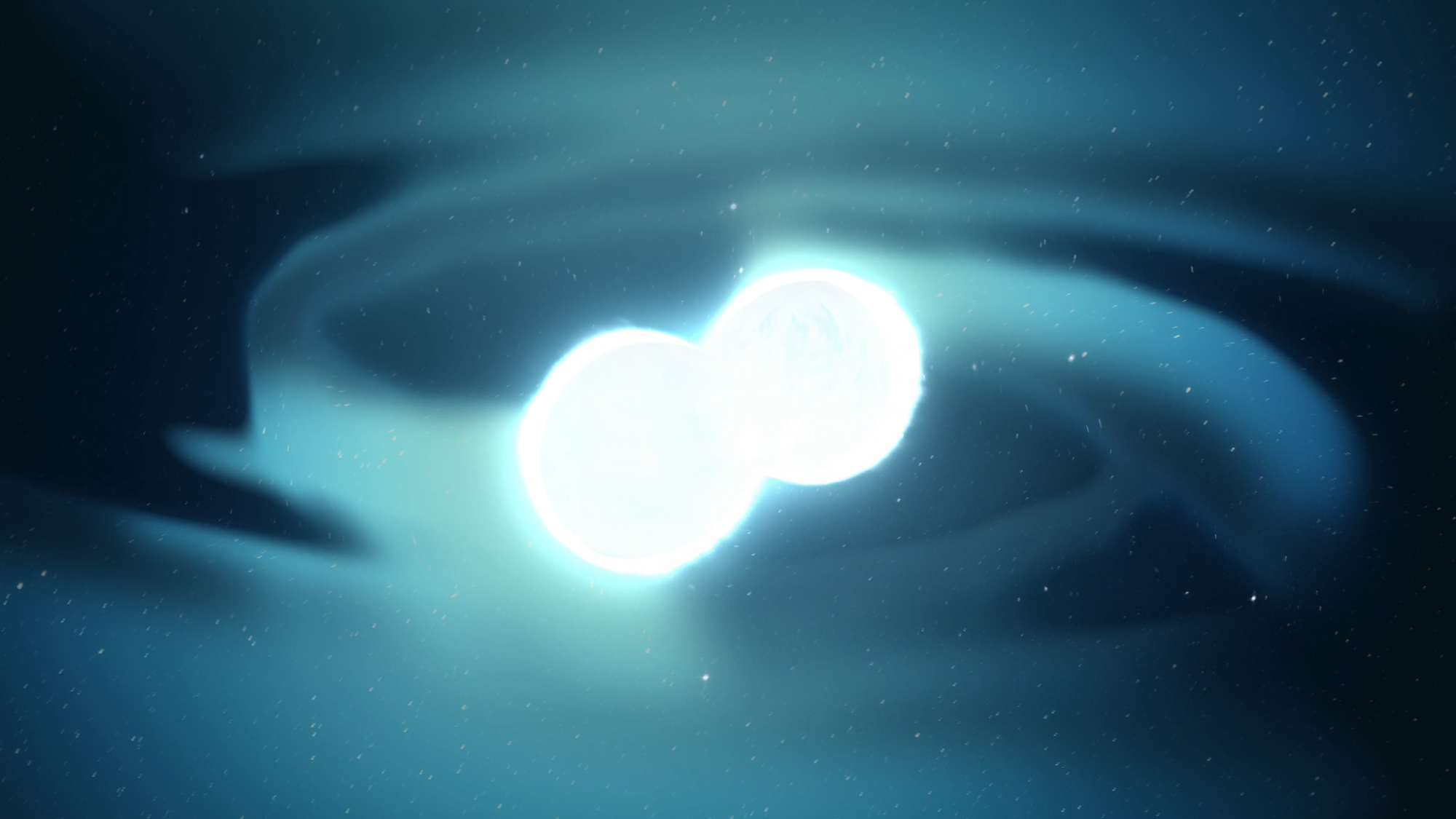'Impossible' neutron stars could explain strange flashes

The oscillating frequencies of two short gamma-ray bursts are the best evidence yet for the formation of 'impossible' hypermassive neutron stars that can briefly defy gravity before collapsing to form a black hole.
A neutron star forms when a large star runs out of fuel and explodes, leaving behind a super-dense remnant that can pack the mass of the sun into the space of a city. Usually, a neutron star can only contain a bit more than two times the mass of the sun before it undergoes gravitational collapse to form a black hole. However, when two regular neutron stars in a binary system merge, their combined mass can exceed this limit — but only briefly, and the stage is difficult to spot.
"We need to start with two light neutron stars in the binary in order to form a hypermassive neutron star, otherwise there would be a direct collapse to a black hole," Cecilia Chirenti, who led the research, told Space.com. Chirenti is an astrophysicist at the University of Maryland, NASA's Goddard Space Flight Center in Maryland and the Center for Mathematics, Computation and Cognition at the Federal University of ABC in Brazil.
Related: 8 ways we know that black holes really do exist
When paired neutron stars collide, they release an explosion of light called a kilonova, a burst of gravitational waves and a short gamma-ray burst (GRB), which is a blast of gamma-rays that typically lasts less than two seconds. And if, as computer simulations predict, hypermassive neutron stars can form initially before collapsing into a black hole, the evidence for these gravity-defying bodies could be found in unexplained oscillations in the frequency of the gamma-rays.
Chirenti's team sifted through records of more than 700 short GRBs to find two short GRBs that stood out as being different. These two GRBs were both detected by the Burst and Transient Source Experiment (BATSE) on NASA's now-retired Compton Gamma-Ray Observatory satellite in the early 1990s. Named GRB 910711 and GRB 931101B, both events displayed somewhat (but not precisely) rhythmic flickers in frequency of their gamma-rays.
Simulations predict that these quasi-periodic oscillations would be a natural outcome of the formation of a hypermassive neutron star, which would have a mass anywhere between 2.5 and 4 solar masses. Such a hypermassive neutron star would not collapse straight away because different parts of the neutron star spin at vastly different rates, which prevents collapse.
Breaking space news, the latest updates on rocket launches, skywatching events and more!
However, a hypermassive neutron star would not be entirely stable, either. Material on its surface would shift, disturbing the orientation of the star's magnetic poles, which emit the gamma-ray jets, in a jittery fashion. Previous searches for GRB oscillations had come up empty because they were looking exclusively for periodic oscillations; Chirenti's team realized that the dynamic properties of a hypermassive neutron star would lead to quasi-periodic oscillations instead. The two candidates they identified, GRB 910711 and GRB 931101B, fit the bill.
And a hypermassive neutron star still won't live very long. Gravitational waves emitted during the merger rob the hypermassive neutron star of some of its angular (rotational) momentum, reducing its spin enough for gravity to take over. "According to the simulations, the hypermassive neutron star will be rotating fast, maybe losing matter and oscillating before collapsing to a black hole with an accretion disk," Chirenti said.
A hypermassive neutron star's lifetime would be several hundred milliseconds. This sounds like a pretty short time, but consider that hypermassive neutron stars would be the fastest spinning stars in the universe, completing one revolution in 1.5 milliseconds or less. A hypermassive neutron star could spin several hundred times before it collapses.
Although finding just two candidates in a sample of over 700 short GRBs could indicate that hypermassive neutron stars might be rare, Chirenti doesn't see it that way.
"There could be other aspects related to the generation of the GRB that could make it hard to detect the signature of a hypermassive neutron star," she said.
The new research represents just one way scientists are looking to understand what happens when neutron stars merge. "There are several ways to probe the end states of neutron star mergers which the community has been pursuing," Wen-fai Fong, an astronomer at Northwestern University who wasn't involved in the new research, told Space.com. "The potential existence of evidence for a supermassive neutron star in archival data is extremely exciting and complementary to existing efforts today of new short gamma-ray bursts across the electromagnetic spectrum."
One way to broaden the search for hypermassive neutron stars is to detect the gravitational waves emitted when they form. According to the simulations, the gravitational waves should also oscillate, but at a frequency too high for the current crop of detectors to measure. However, the frequency modulation of the gravitational waves "should be detectable by the next generation of gravitational-wave detectors in 10 to 15 years," Chirenti said.
The results were published on Jan. in the journal Nature; Chirenti also presented the results at the 241st meeting of the American Astronomical Society, held this week in Seattle and virtually. The full paper can be read on the arXiv preprint server.
Space.com contributing writer Robert Lea provided reporting for this story. Follow Keith Cooper on Twitter @21stCenturySETI. Follow us on Twitter @Spacedotcom and on Facebook.

Keith Cooper is a freelance science journalist and editor in the United Kingdom, and has a degree in physics and astrophysics from the University of Manchester. He's the author of "The Contact Paradox: Challenging Our Assumptions in the Search for Extraterrestrial Intelligence" (Bloomsbury Sigma, 2020) and has written articles on astronomy, space, physics and astrobiology for a multitude of magazines and websites.

